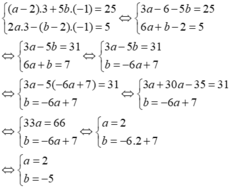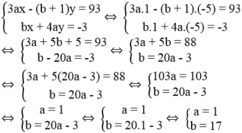Tìm a, b để hệ phương trình 2 a x + b y = − 1 b x − a y = 5 có nghiệm là (3; −4)
A. a = 1 2 ; b = 1
B. a = - 1 2 ; b = 1
C. a = 1 2 ; b = - 1
D. a = - 1 2 ; b = - 1
Hãy nhập câu hỏi của bạn vào đây, nếu là tài khoản VIP, bạn sẽ được ưu tiên trả lời.

Đặt \(x+\dfrac{1}{x}=a;y+\dfrac{1}{y}=b\left(\left|a\right|\ge2;\left|b\right|\ge2\right)\)
\(\left\{{}\begin{matrix}x+\dfrac{1}{x}+y+\dfrac{1}{y}=5\\x^3+y^3+\dfrac{1}{x^3}+\dfrac{1}{y^3}=15m-25\end{matrix}\right.\)
\(\Leftrightarrow\left\{{}\begin{matrix}x+\dfrac{1}{x}+y+\dfrac{1}{y}=5\\\left(x^3+\dfrac{1}{x^3}\right)+\left(y^3+\dfrac{1}{y^3}\right)=15m-25\end{matrix}\right.\)
\(\Leftrightarrow\left\{{}\begin{matrix}x+\dfrac{1}{x}+y+\dfrac{1}{y}=5\\\left(x+\dfrac{1}{x}\right)^3-3\left(x+\dfrac{1}{x}\right)+\left(y+\dfrac{1}{y}\right)^3-3\left(y+\dfrac{1}{y}\right)=15m-25\end{matrix}\right.\)
\(\Leftrightarrow\left\{{}\begin{matrix}x+\dfrac{1}{x}+y+\dfrac{1}{y}=5\\\left(x+\dfrac{1}{x}\right)^3+\left(y+\dfrac{1}{y}\right)^3-3\left(x+\dfrac{1}{x}+y+\dfrac{1}{y}\right)=15m-25\end{matrix}\right.\)
\(\Leftrightarrow\left\{{}\begin{matrix}x+\dfrac{1}{x}+y+\dfrac{1}{y}=5\\\left(x+\dfrac{1}{x}\right)^3+\left(y+\dfrac{1}{y}\right)^3=15m-10\end{matrix}\right.\)
\(\Leftrightarrow\left\{{}\begin{matrix}a+b=5\\a^3+b^3=15m-10\end{matrix}\right.\)
\(\Leftrightarrow\left\{{}\begin{matrix}a+b=5\\\left(a+b\right)^3-3ab\left(a+b\right)=15m-10\end{matrix}\right.\)
\(\Leftrightarrow\left\{{}\begin{matrix}a+b=5\\125-15ab=15m-10\end{matrix}\right.\)
\(\Leftrightarrow\left\{{}\begin{matrix}a+b=5\\ab=9-m\end{matrix}\right.\)
\(\Rightarrow a,b\) là nghiệm của phương trình \(t^2-5t+9-m=0\left(1\right)\)
a, Nếu \(m=3\), phương trình \(\left(1\right)\) trở thành
\(t^2-5t+6=0\)
\(\Leftrightarrow\left[{}\begin{matrix}t=2\\t=3\end{matrix}\right.\)
\(\Leftrightarrow\left[{}\begin{matrix}\left\{{}\begin{matrix}a=2\\b=3\end{matrix}\right.\\\left\{{}\begin{matrix}a=3\\b=2\end{matrix}\right.\end{matrix}\right.\)
TH1: \(\left\{{}\begin{matrix}x+\dfrac{1}{x}=2\\y+\dfrac{1}{y}=3\end{matrix}\right.\Leftrightarrow\left\{{}\begin{matrix}\left(x-1\right)^2=0\\y^2-3y+1=0\end{matrix}\right.\Leftrightarrow\left\{{}\begin{matrix}x=1\\y=\dfrac{3\pm\sqrt{5}}{2}\end{matrix}\right.\)
TH2: \(\left\{{}\begin{matrix}x+\dfrac{1}{x}=3\\y+\dfrac{1}{y}=2\end{matrix}\right.\Leftrightarrow\left\{{}\begin{matrix}x=\dfrac{3\pm\sqrt{5}}{2}\\y=1\end{matrix}\right.\)
Vậy ...
b, \(\left(1\right)\Leftrightarrow t=\dfrac{5\pm\sqrt{4m-11}}{2}\left(m\ge\dfrac{11}{4}\right)\)
\(\left(1\right)\Leftrightarrow\left\{{}\begin{matrix}a=\dfrac{5\pm\sqrt{4m-11}}{2}\\b=\dfrac{5\mp\sqrt{4m-11}}{2}\end{matrix}\right.\)
\(\Leftrightarrow\left\{{}\begin{matrix}x+\dfrac{1}{x}=\dfrac{5\pm\sqrt{4m-11}}{2}\\y+\dfrac{1}{y}=\dfrac{5\mp\sqrt{4m-11}}{2}\end{matrix}\right.\)
\(\Leftrightarrow\left\{{}\begin{matrix}2x^2-\left(5\pm\sqrt{4m-11}\right)+2=0\left(2\right)\\2y^2-\left(5\mp\sqrt{4m-11}\right)+2=0\end{matrix}\right.\)
Yêu cầu bài toán thỏa mãn khi phương trình \(\left(2\right)\) có nghiệm dương
\(\Leftrightarrow\left\{{}\begin{matrix}\Delta=\left(5\pm\sqrt{4m-11}\right)^2-16\ge0\\\dfrac{5\pm\sqrt{4m-11}}{2}>0\\1>0\end{matrix}\right.\)
\(\Leftrightarrow...\)

Để hệ phương trình a - 2 x + 5 b y = 25 2 a x - b - 2 y = 5 có nghiệm là (x; y) = (3; -1) thì (x;y) = (3; -1) thỏa mãn hệ phương trình
Thay x = 3, y = -1 vào hệ phương trình ta được:

Vậy với a = 2, b = -5 thì hệ phương trình a - 2 x + 5 b y = 25 2 a x - b - 2 y = 5 có nghiệm là (x;y) = (3; -1)

Thay x = 1, y = -5 vào hệ phương trình ta được:

Vậy khi a = 1,b = 17 thì hệ phương trình 3 a x - b + 1 y = 93 b x + 4 a y = - 3 có nghiệm là (x; y) = (1; -5).

a Để hpt có nghiệm \(\left(x;y\right)=\left(-2;3\right)\) \(\Rightarrow\left\{{}\begin{matrix}-2+3m=4\\-2n+3=-3\end{matrix}\right.\) \(\Leftrightarrow\left\{{}\begin{matrix}3m=6\\-2n=-6\end{matrix}\right.\Leftrightarrow\left\{{}\begin{matrix}m=2\\n=2\end{matrix}\right.\)
b Để hpt có vô số nghiệm \(\Leftrightarrow\dfrac{1}{n}=\dfrac{m}{1}=\dfrac{4}{-3}\) \(\left(\dfrac{a}{a'}=\dfrac{b}{b'}=\dfrac{c}{c'}\right)\)
\(\Leftrightarrow\left\{{}\begin{matrix}\dfrac{1}{n}=-\dfrac{4}{3}\\m=-\dfrac{4}{3}\end{matrix}\right.\) \(\Leftrightarrow\left\{{}\begin{matrix}m=-\dfrac{4}{3}\\n=-\dfrac{3}{4}\end{matrix}\right.\)
Vậy...
Thay x = 3; y = −4 vào hệ phương trình ta được
2 a .3 + b − 4 = − 1 b .3 − a . − 4 = 5 ⇔ 6 a − 4 b = − 1 4 a + 3 b = 5 ⇔ 12 a − 8 b = − 2 12 a + 9 b = 15 ⇔ 17 b = 17 4 a + 3 b = 5 ⇔ b = 1 a = 1 2
Vậy a = 1 2 ; b = 1
Đáp án: A